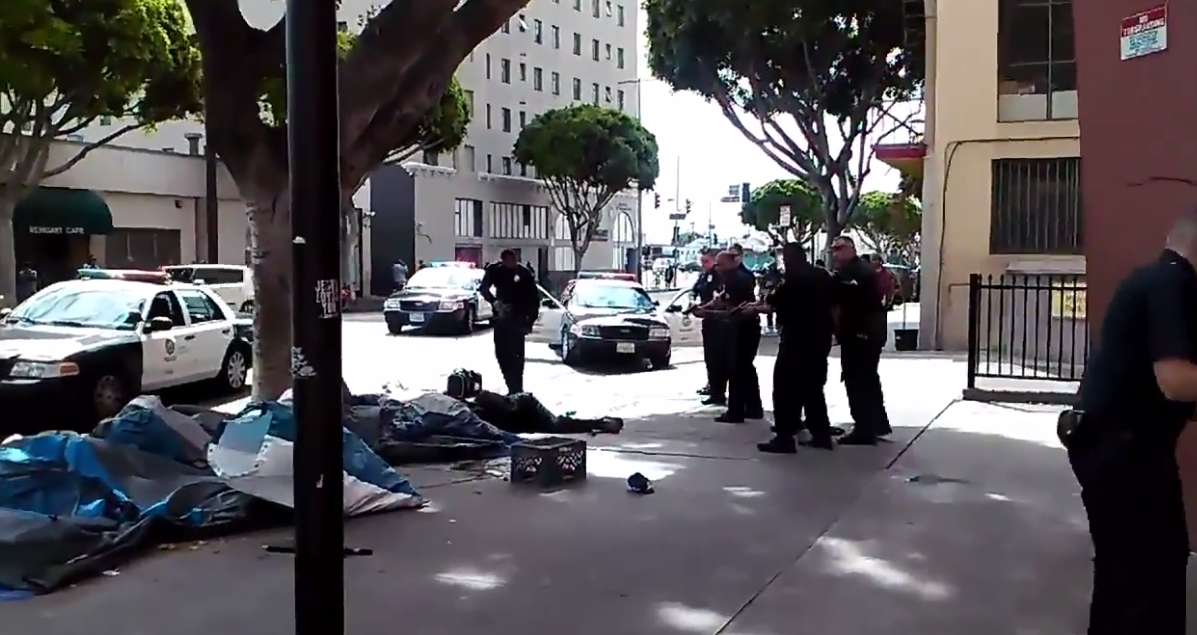
After attempting to subdue a homeless robbery suspect with a Taser, Los Angeles police fatally shot him on Sunday, the LAPD confirmed in a statement.
Officers approached the man and "after making contact...the suspect began fighting and physically resisting the officers' attempts to take him into custody." The department said officers then used the Taser but he "continued to fight and resist the officers and fell to the ground. While on the ground, the suspect and officers struggled over one of the officer's handguns and then an officer-involved shooting occurred."
The shooting was caught on video, which has since circulated on the Internet.
The LAPD's Force Investigative Division and Office of Inspector General are reviewing the incident and will present their findings to the Board of Police Commissioners "to determine whether the use of deadly force was consistent with Department policies and procedures." The Los Angeles County District Attorney's Justice System Integrity Division will also investigate, according to the police. LAPD Commander Andrew Smith said the Taser was "ineffective," according to the Los Angeles Times.
Smith's statement brings up several important questions, including: Are Tasers effective? And if they aren't, why not and in what circumstnaces?
Newsweek spoke to several Taser experts across the country about these devices. To be clear, they all spoke generally about Tasers, not about this specific incident in L.A. When used correctly, Tasers do subdue suspects, they said, but factors such as distance between the officer and suspect can have a dramatic impact on efficacy. (It's worth mentioning that critics of Tasers "have implicated [them] in hundreds of deaths nationwide," according to The New York Times. An Amnesty International analysis from 2012 put the known U.S. Taser death toll at around 500.)
David Hayes, retired chief of the Alton, Illinois Police Department and presently assistant director of the Southwestern Illinois Law Enforcement Commission (SILEC), supervised Taser use in his department and oversees Taser training with the commission. Hayes explained that for a Taser to work, both probes deployed from the device must hit the target.
That's because these two probes create an electric circuit, one providing a positive and the other a negative charge. This completed circuit allows current to flow through the target's body. This in turn temporarily subdues the person by disrupting electrical signals between the brain and muscles.
So, if the officer lands only one of the probes, the Taser doesn't work.
"If you were to plug in a blow dryer with one prong, you would get nothing," Steve Tuttle, a spokesman for Taser (the company), explains. "You need to complete the circuit with the opposite polarity, a positive and a negative."
Landing both probes, Hayes said, can be difficult when an officer is running after someone or trying to wrangle a suspect who is physically resisting arrest. When both probes do hit the target, the effect is most impactful when they are spread across the body, rather than right next to each other, to maximize the muscle groups impacted.
The distance between the Taser and the suspect also impacts efficacy—the farther a Taser is from its target, the farther the wires separate upon deployment, decreasing the chances both probes will hit, Hayes said. Tuttle said most Tasers in the field feature 25-foot wires, and most are deployed at a distance of 7 to 12 feet from a suspect.
When both probes make contact, Hayes said, Tasers work "probably 99 out of 100" times.
"Are Tasers effective? Yes, if you are using it properly," said Frank Borelli, editor of Officer.com, who has worked in law enforcement for 30 years, 25 as a police instructor and 10 of those as a Taser instructor. "In highly dynamic situations, it's difficult to always do things perfectly. That's why in actual real-life shootings with handguns, police officers only have a 20 percent hit rate."
Kevin Davis, a 32-year law enforcement veteran who wrote Use of Force Investigations: A Manual for Law Enforcement, also trumpeted these devices, saying: "The Taser has a very good track record: over 80 percent of people that are Tasered are controlled." Plus, there are fewer officer injuries because "it can be used from a distance."
Officers can also take advantage of other Taser methods, including what's called "drive stun" mode. Drive stun mode involves removing the part of the Taser that deploys the probes and then placing the device against a suspect's skin. This mode works more like a traditional stun gun, subduing the suspect by inflicting pain, Davis said. But drive stun isn't as effective as the normal method, he said, especially with suspects under the influence or suffering from psychosis, who might not be affected by pain.
There's also a method called a "drive stun follow-up," Tuttle said. This is when an officer places the Taser against a suspect who has been hit by one of the probes. This completes the circuit, immobilizing the suspect.
Speaking generally of Taser efficacy, and not of the LAPD incident, Tuttle said: "We are the single most effective less-lethal tool in the world. Because we don't rely on pain compliance, it is a much more effective tool than pepper spray or baton strikes, and much less injurious. We have had a 94 percent field success rate for about the past two decades." He chalked the remaining six percent up to "typically a single probe hit only, a clothing disconnect or a probe spread issue."
As of press time, the LAPD had not given Newsweek further details on why the Taser used on Sunday didn't perform correctly. "The incident is still under investigation," a spokeswoman said.
Uncommon Knowledge
Newsweek is committed to challenging conventional wisdom and finding connections in the search for common ground.
Newsweek is committed to challenging conventional wisdom and finding connections in the search for common ground.
About the writer
Before joining Newsweek, Victoria Bekiempis worked at DNAinfo.com New York and the Village Voice. She also completed internships at news ... Read more
To read how Newsweek uses AI as a newsroom tool, Click here.








